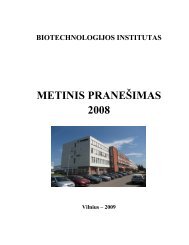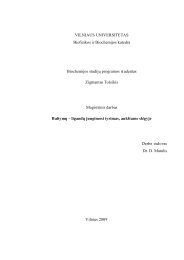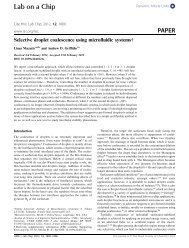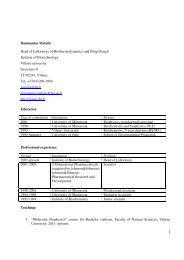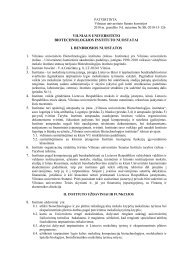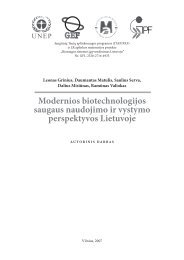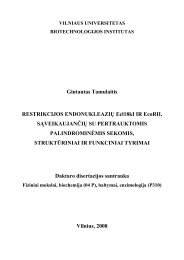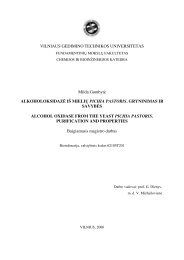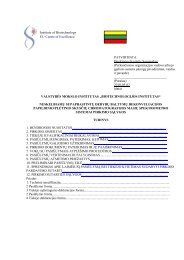Report 2008-2010
Report 2008-2010
Report 2008-2010
You also want an ePaper? Increase the reach of your titles
YUMPU automatically turns print PDFs into web optimized ePapers that Google loves.
51<br />
Voroprot: an interactive software tool for visualization and analysis<br />
of various geometric features of protein structure<br />
The ability to visualize and analyze geometric features of the 3D protein<br />
structure is fundamental in protein modeling, residue packing,<br />
docking, protein-protein interactions and other computational studies.<br />
Most interactive viewers are limited to standard representations<br />
of protein structure such as lines, cartoon-like diagrams, CPK representation<br />
and, sometimes, surfaces. To address the shortage of advanced<br />
protein structure analysis software, we developed Voroprot, a<br />
tool that extensively relies on the Voronoi and Apollonius diagrams<br />
and the Apollonius graph. Voroprot can construct interatomic contact<br />
and solvent accessible surfaces. It can also find internal cavities and<br />
pockets. In addition, Voroprot can construct a triangulated representation<br />
of the 3D protein structure, which is useful in investigation of<br />
protein surface curvature. Voroprot allows the visualization of every<br />
constructed geometric object and is capable of producing publication-quality<br />
images (Fig. 3). Voroprot is an easy setup standalone application<br />
available for Windows, Linux and Mac OS X platforms.<br />
Voroprot is free for academic use and can be downloaded from<br />
http://www.ibt.lt/bioinformatics/software/voroprot/.<br />
All the methods that have been developed in our laboratory can be<br />
accessed through our website at: http://www.ibt.lt/bioinformatics/software/.<br />
Application of computational biology methods to specific biological<br />
problems<br />
An important element of our laboratory research is projects in which<br />
computational methods alone or combined with experiments (in collaboration<br />
with experimental labs) are applied to address specific biological<br />
questions. Most of these ongoing projects involve proteins<br />
participating in DNA metabolism, in particular in DNA replication and<br />
repair. One of the projects listed below is described in detail.<br />
• Computational analysis of the nature and distribution of DNA replication<br />
processivity components in genomes of double stranded<br />
DNA viruses<br />
• Computational analysis of evolutionary distribution and structural<br />
properties of bacterial polymerase III catalytic subunits<br />
• Computational identification and characterization of putative Type<br />
I and III restriction-modification systems in bacterial genomes.<br />
• Elucidation of the three-dimensional structure and molecular mechanisms<br />
of the T4 bacteriophage replisome (collaboration with Prof.<br />
Virgis Šikšnys, Institute of Biotechnology)<br />
• Computational/experimental studies of molecular functions of Elg1,<br />
a protein involved in the maintenance of genome stability in eukaryotes<br />
(collaboration with Prof. Martin Kupiec, Tel Aviv University)<br />
• Molecular mechanisms of yeast Rad5 and its human ortholog, HLTF,<br />
in conferring DNA damage tolerance (collaboration with Dr. Lajos<br />
Haracska, Biological Research Center, Szeged)<br />
• Molecular mechanisms of M. tuberculosis DNA mutagenesis (collaboration<br />
with Prof. Valerie Mizrahi, University of the Witwatersrand,<br />
Johannesburg)<br />
Computational modeling in studies of mechanisms of M. tuberculosis<br />
DNA mutagenesis<br />
The emergence of drug-resistant Mycobacterium tuberculosis (Mtb)<br />
strains is an important world-wide problem. The major cause of drug<br />
resistance in Mtb is thought to be the inducible mutagenesis. In Mtb,<br />
the induced base-substitution mutagenesis is dependent on DnaE2,<br />
the C-family DNA polymerase, and two other proteins, Rv3395c<br />
(ImuA’) and Rv3394c (ImuB). Rv3395c is a protein of unknown function<br />
very distantly related to RecA (Fig. 4), and Rv3394c is its downstream<br />
partner predicted to encode a specialist Y-family DNA<br />
polymerase.<br />
Figure 3. Visual analysis of the crystal structure of green fluorescent protein<br />
(GFP; PDB code: 1EMA) using Voroprot. (A) The Voronoi cells of the atoms<br />
of some of the residues inside. (B) Cavities inside the protein structure found<br />
by rolling water molecule on the protein surface. (C) The Apollonius graph<br />
of GFP atoms with some of the cavities shown in yellow. (D) The Voronoi<br />
cells of the chromophore atoms with their faces colored by identities of their<br />
neighbours.



